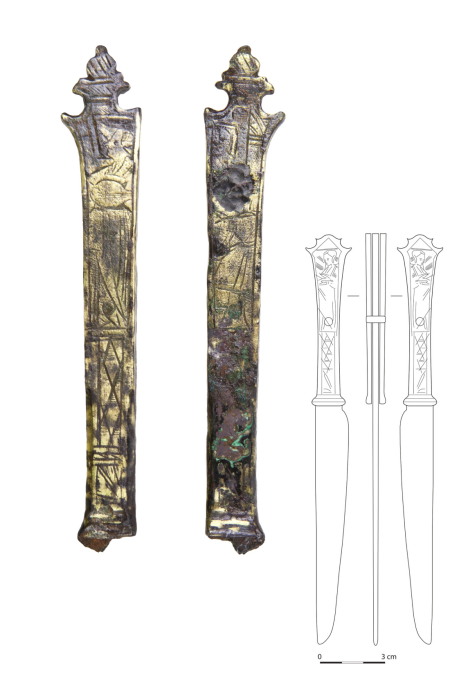Simple registration of archaeological metal finds
There’s lots of metal hidden in Flemish soil. Archaeological excavations and metal detectorists regularly discover metal objects, and there have been numerous finds of copper alloys, precious metals, lead (alloys) and iron from the period 1000-1600, largely because of the wealth and diversity of material culture during this time.
In order to enable broader research by archaeologists and historians, and help with the identification of metal objects found in future excavations, we’re providing access to information about metal finds over the last few decades. How and why? We dig deeper into that here.
Challenge
Metal finds are currently not dealt with in sufficient detail in scientific research or archaeological activities carried out by the general public.

Knife handle, Mechelen - Begijnenstraat, 1350-1450 (© CAR vzw) and reference sketch of a Late-/Postmedieval type of knife (© Portable Antiquities Netherlands/RCE)
Only a few categories of finds – such as coins and pilgrim badges – are already subject to detailed research because they are also relevant for related sciences such as art.
Unfortunately, unknown also means unresearched and unloved. So, in order to give them the place in archaeological and scientific research that they deserve, we’re developing a comprehensive reference typology for medieval metal objects. This has been made possible thanks to the ‘archaeological synthesis research’ grant awarded by Vrije Universiteit Brussels and Histories for the project ‘Medieval Metal: research into metal material culture in Flemish cities, 1000-1600 AD’.
Our role
To enable the integration of a whole range of metal finds, we’re working with graphs in this project. A graph is a descriptive model that looks like a widespread network of links that can be easily extended. For this project, as our starting point we’re using an existing graph that is already used for describing metal detector finds, and extending it to also describe metal finds from excavations.
In addition to extending the graph, we’re also supervising the development of a CSV upload tool, which we can use to upload data from historical finds. We Connect Data is taking care of developing the graph database and CSV upload tool.
Approach
Existing data in conventional tables can be mapped into this graph using a CSV template that we’ve developed. The Middeleeuws Metaal (Medieval Metal) project inventory will be included in the same graph as MEDEA and vondsten.be. There will also be two separate web gateways for finds from excavations:
a catalogue where you can view finds on a map (just like vondsten.be, but with data concentrated on specific excavated sites).
an identification guide where you can search by object type.
The latter is extremely useful for helping archaeologists to better identify metal objects and compare them with existing finds. The database is added to by importing metal finds from excavations performed by commercial archaeological firms and metal detectorists. This will serve as the basis for a new identification guide which will be developed once we have tested that the graph database is properly configured and the web gateways are working as they should.
